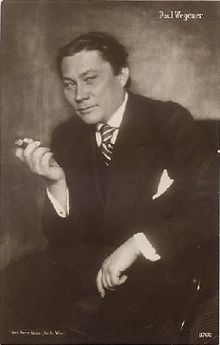Paul Wegener
This article has multiple issues. Please help improve it or discuss these issues on the talk page. (Learn how and when to remove these template messages)
|
Paul Wegener | |
|---|---|
 | |
| Born | 11 December 1874 |
| Died | 13 September 1948 (aged 73) |
| Occupation | Actor |
| Spouse(s) | Lyda Salmonova (divorced, remarried) Greta Schröder (m.1924, divorced) |
| Children | 1 |
| Relatives | Alfred Wegener (cousin) Kurt Wegener (cousin) |
Paul Wegener (11 December 1874 – 13 September 1948) was a German actor, writer, and film director known for his pioneering role in German
Acting career
At the age of 20, Wegener decided to end his law studies and concentrate on acting, touring the provinces before joining
Another of his early films was Der Yoghi (1916), in which he played the role of a
In 1926, he appeared in his only Hollywood film,
In 1932, Wegener made his sound debut in
Life under the Nazi regime

When in 1933 the
Personal life
He was married six times, thirdly and sixthly to the actress
Late career and death
Wegener's last film was Der Grosse Mandarin (1948). In July 1948 he reprised his old role as Nathan the Wise at the Deutschen Theatre, but in the very first scene he collapsed and the curtain was brought down. Two months later, on 13 September 1948, he died in his sleep.
Selected filmography
Actor
- The Student of Prague (1913)
- The Golem (1915) [Lost film, only fragments survive]
- The Golem and the Dancing Girl (1917) [Lost film]
- Rübezahl's Wedding (1916)
- The Yogi (1916)
- Hans Trutz in the Land of Plenty (1917)
- The Pied Piper of Hamelin (1918)
- The Foreign Prince (1918)
- The Galley Slave (1919)
- Figures of the Night (1920)
- The Golem: How He Came into the World (1920).
- Roswolsky's Mistress (1921)
- Loves of Pharaoh (1922)
- A Dying Nation (1922)
- The Love Nest (1922)
- Monna Vanna (1922)
- Lucrezia Borgia (1922)
- Vanina (1922)
- The Treasure of Gesine Jacobsen (1923)
- The Island of Tears (1923)
- Living Buddhas (1925)
- The Magician (1926)
- The Strange Case of Captain Ramper (1927)
- Queen of the Boulevards (1927)
- Poor Little Sif (1927)
- Svengali (1927)
- The Weavers (1927)
- World Without Weapons (1927)[3]
- Alraune (1928) co-starring Brigitte Helm
- Unheimliche Geschichten (1932)
- Marshal Forwards (1932)
- The Secret of Johann Orth (1932)
- Inge and the Millions (1933)
- ... nur ein Komödiant (1935)
- The Right to Love (1939)
- Twilight (1940)
- My Life for Ireland (1941)
- The Girl from Fano (1941)
- Diesel (1942)
- Wedding in Barenhof (1942)
- The Great Mandarin (1949)
- Eyes of Love (1951)
Director
- The Student of Prague (1913)
- The Golem (1915) [Lost film]
- Rübezahl's Wedding (1916)
- The Yogi (1916)
- The Golem and the Dancing Girl (1917) [Lost film]
- Hans Trutz in the Land of Plenty (1917)
- The Foreign Prince (1918)
- The Pied Piper of Hamelin (1918)
- The Galley Slave (1919)
- The Golem: How He Came into the World (1920)
- The Girlfriend of a Big Man (1934)
- Augustus the Strong (1936)
- The Hour of Temptation (1936)
- Moscow-Shanghai(1936)
References
- ^ a b photo, from the Berlin production, Retrieved 27 July 2015
- ^ "Der Student von Prag (1913) – Overview – MSN Movies". Archived from the original on 23 September 2012. Retrieved 26 June 2011.
- ^ Henry Nicolella and John T. Soister. Many Selves: The Horror and Fantasy Films of Paul Wegener. BearManor Media. pp. 442–. GGKEY:615ZSK679BA.
Further reading
- Monty Jacobs: Der Schauspieler Paul Wegener. Verlag Erich Reiß, Berlin [ca. 1924]
- Kai Möller, ed.: Paul Wegener. Sein Leben und seine Rollen. Rowohlt, Hamburg 1954
- Wolfgang Noa: Paul Wegener. Henschel, Berlin 1964
- Herbert Pfeiffer: Paul Wegener. Rembrandt, Berlin 1957
- Heide Schönemann: Paul Wegener. Frühe Moderne im Film. Menges, Stuttgart 2003 ISBN 3-932565-14-2
- Hans Günther Pflaum: 'Kinetische Lyrik. P. W.s "Rübezahls Hochzeit" 1916' in: Peter Buchka, ed.: Deutsche Augenblicke. Eine Bilderfolge zu einer Typologie des Films (Reihe: "Off-Texte" 1, des Münchener Filmmuseums) Belleville, München 1996 ISBN 3-923646-49-6
- Hans Günther Pflaum: 'Ins eigene Herz. P. W.s "Student von Prag" 1919' in: Peter Buchka, ed.: Deutsche Augenblicke; pp. 20f.
